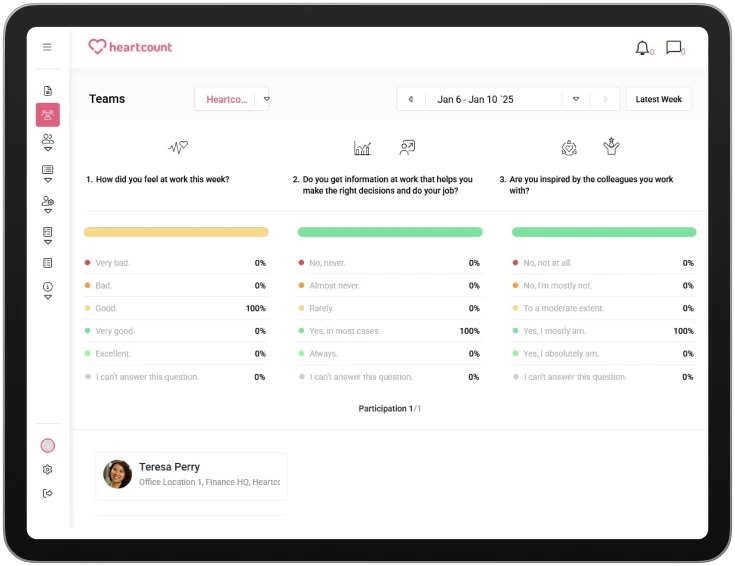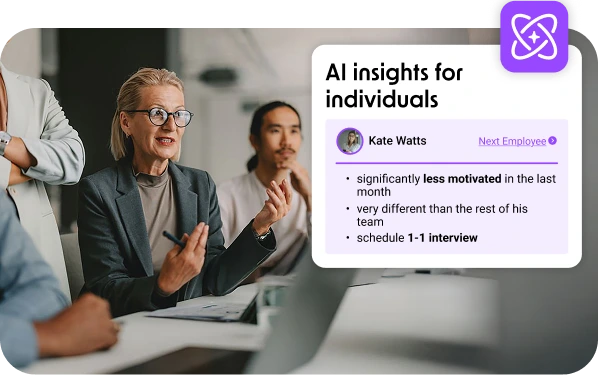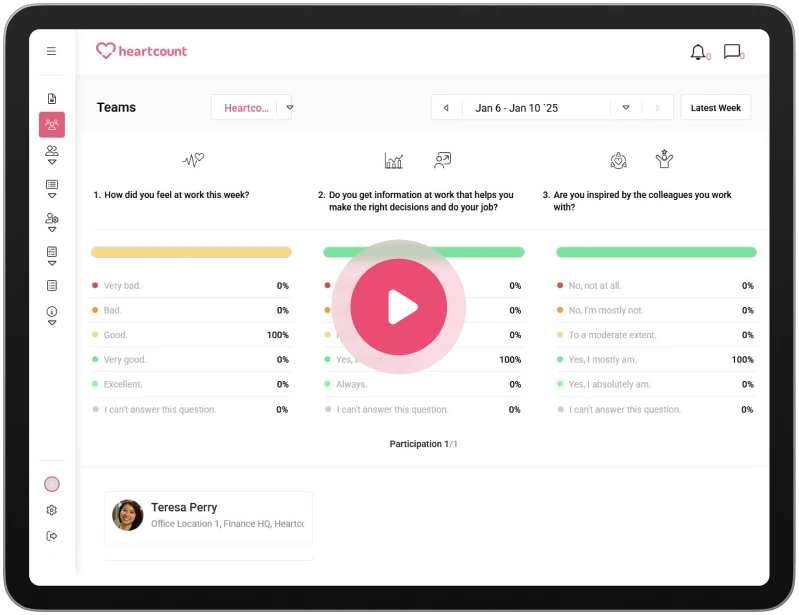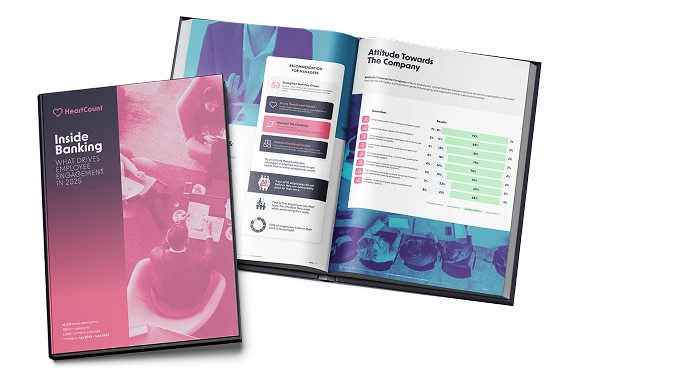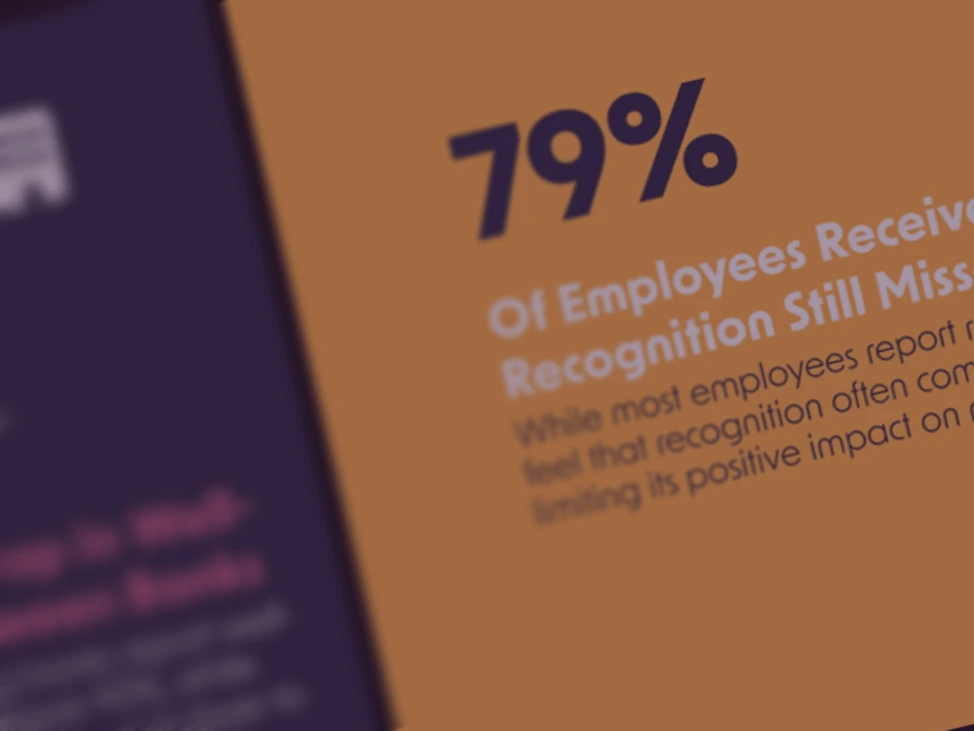Workplace Transparency: How Honest Communication Builds Stronger Teams

-
1.Workplace Transparency: How Honest Communication Builds Stronger Teams
-
2.What Is Transparency in the Workplace?
-
3.The Benefits of Transparency in the Workplace
-
4.What Happens When Transparency Is Lacking?
-
5.How to Improve Transparency in the Workplace
-
6.The Role of Leadership in Driving Workplace Transparency
-
7.Workplace Transparency Examples From Leading Companies
-
8.Conclusion: Transparency Is a Culture, Not a Checkbox
-
9.FAQs About Workplace Transparency
Workplace Transparency: How Honest Communication Builds Stronger Teams
In today’s workplace, transparency is no longer optional. People want to know what’s happening, why decisions are made, and how they fit into the bigger picture. When that clarity is missing, trust erodes. When it’s present, culture strengthens, and so does performance.
At HeartCount, we work with teams every day who are making transparency a core part of how they operate. Not through slogans, but through real-time feedback, open communication, and leadership that listens and responds.
What Is Transparency in the Workplace?
Transparency in the workplace means more than just sharing updates or policies. It’s about building a culture where communication is open, decisions are explained, and trust flows both ways. When people feel informed and included, they’re more likely to stay engaged, speak up, and align with company goals. In fact, Deloitte’s 2024 Human Capital Trends report found that 86% of workers and 74% of business leaders say transparency and trust are critical to organizational success in the years ahead. It’s not just a cultural ideal. It’s a performance driver.
A Clear Definition (With Examples)
Workplace transparency means giving employees the information they need to understand the bigger picture, and trusting them enough to share it. That includes explaining the “why” behind decisions, making expectations visible, and being honest about both wins and challenges.
For example, leadership transparency might include sharing financial targets or changes to strategic direction before they’re finalized, not just after. Peer-level transparency could be as simple as teammates clearly outlining responsibilities at the start of a project or offering constructive feedback in real time.
Real-world examples? A product team might use a shared decision log that everyone can access, documenting how and why key calls were made. Or a people manager might invite their team to review and contribute to planning documents before locking in deliverables. In both cases, the common thread is trust: no hidden agendas, no “need-to-know-only” silos.
Why Transparency Matters in 2025
In 2025, employees are asking tougher questions, and expecting honest answers. With hybrid work, frequent org changes, and higher stakes around inclusion and belonging, clarity is currency. Transparency reduces anxiety during change, keeps distributed teams aligned, and helps people connect to purpose.
It also directly shapes how employees experience their workplace. McKinsey research shows that trust in leadership grows significantly when companies openly communicate about strategy, expectations, and rationale. And when employees trust the people leading them, they’re far more likely to stay, grow, and contribute their best work.
COLLECT
The Benefits of Transparency in the Workplace
Transparency isn’t just a nice-to-have. It’s one of the fastest ways to build a culture people actually want to be part of. When decisions are visible, feedback loops are open, and everyone understands what’s going on, trust builds naturally. That shows up in engagement scores, rising culture of collaboration, and retention. People feel safer, more valued, and more motivated when they’re not stuck guessing.
We see it every day: when teams share openly and consistently, culture shifts, faster than most leaders expect.
Builds Trust and Engagement
Trust doesn’t come from big announcements or flashy values. It comes from consistency. When employees see that information is shared clearly, that feedback is acknowledged, and that nothing critical is hidden behind closed doors, they start to believe in the system. They stop checking out. They speak up.
Making recognition and feedback visible also reinforces what matters. When people are praised publicly or their input leads to real change, they feel seen. And they stay engaged.
Improves Collaboration and Decision-Making
Teams can’t collaborate if they don’t know what’s happening. Trust and transparency in the workplace helps people understand priorities, timelines, and roles, without needing to chase down information or interpret vague Slack messages. When decisions are documented and shared, people can move forward without second-guessing.
Clarity speeds everything up. It also reduces conflict, because people aren’t working from different assumptions. Transparency doesn’t mean every detail has to be public, but the right people should always have the right context.
Attracts and Retains Top Talent
People want clarity. When a workplace is open about its values, goals, and internal processes, it sends a clear message: we trust our people. That kind of culture attracts candidates who care about alignment, not just compensation. And for existing employees, it builds loyalty. If they feel included in the conversation, even during change, they’re more likely to stick around.
If you’re working to improve employee engagement and retention, transparency is one of the simplest, most scalable levers to start with. It doesn’t cost anything to be clear. But it costs a lot to let people operate in the dark.
What Happens When Transparency Is Lacking?
A lack of transparency in the workplace doesn’t just lead to confusion. It erodes trust, weakens culture, and drives people away. When employees don’t know what’s happening or why decisions are being made, uncertainty fills the gaps. That uncertainty often leads to assumptions, rumours, and disengagement. Over time, even high-performing teams start to pull back. Trust breaks down. Alignment disappears. And people start looking elsewhere.
This checklist of toxic workplace patterns shows just how quickly things can shift when communication is missing or unclear. The symptoms are easy to miss at first, but they spread fast.
Signs of a Non-Transparent Workplace
You don’t need a full-blown crisis to spot transparency issues. Some of the most common signs include:
- Major decisions announced without context
- Shifting priorities that aren’t explained
- Feedback ignored or quietly dismissed
- Leadership updates that feel overly vague or curated
- Employees left out of conversations that directly affect their work
When these patterns repeat, employees start to feel like they’re on the outside looking in.
Consequences: Mistrust, Turnover, and Burnout
A culture of secrecy creates emotional distance. When people don’t feel informed, they’re less likely to trust leadership, or stick around. Lack of communication also increases stress. Without context, employees may worry about their performance, their place in the team, or what’s coming next.
Turnover often rises in low-trust environments, especially when decisions feel hidden or inconsistent. Even those who stay may disengage to protect themselves. Employee burnout isn’t far behind when people are expected to adapt without clarity or support.
How Hidden Decisions Undermine Culture
Every time leadership makes a decision without explanation, it creates distance. Employees want to understand the “why,” not just be handed the “what.” When context is missing, it sends the message that input isn’t needed or welcome.
Over time, this discourages curiosity and openness. People stop asking questions. They stop offering ideas. And the culture shifts from collaborative to cautious. Transparency doesn’t mean oversharing. It means being intentional about communication, so people feel informed, respected, and part of the process.
How to Improve Transparency in the Workplace
Transparency isn’t something you can fix with a single announcement. It takes structure, repetition, and a clear intention behind how information flows across the organisation. The goal isn’t to share everything, it’s to share the right things at the right time, with the right context.
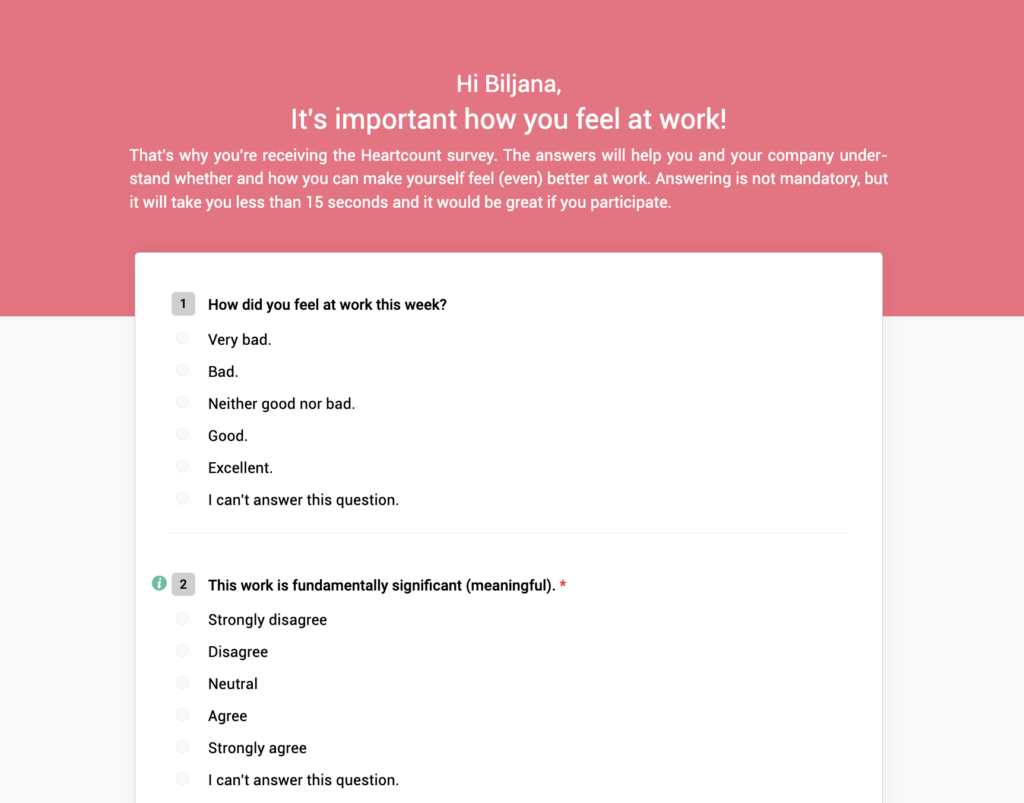
7 Proven Practices to Promote Openness
These seven practices can help build a more open, trusting culture, whether your team is in-office, remote, or somewhere in between.
1. Define “Transparency” for Your Organization
Clarity starts with alignment. Make sure everyone understands what transparency means in your context. Is it about sharing strategy updates? Explaining decisions before they’re made? Inviting feedback across teams? Write it down. Talk about it. Set expectations early so transparency doesn’t become an empty buzzword.
2. Communicate Early, Often, and Clearly
Timing matters. When leaders wait too long to share updates, or only communicate when something’s final, it erodes trust. Being transparent means bringing people into the process sooner. Even if the message is “we’re still figuring this out,” it gives employees a sense of inclusion. And when you do share, drop the jargon. Say what you mean in plain language.
3. Invite Feedback and Act on It
Transparency is a two-way conversation. Create regular channels for employees to share feedback, and show that their input leads to action. That doesn’t mean every suggestion gets implemented. But when people see that their voice is heard and taken seriously, trust grows. Custom surveys are one way to do this, as tailored listening gives you better insight into what matters most.
4. Document and Share Decisions
When decisions are made, make the thinking behind them visible. Even a short summary of why something changed can reduce confusion and pushback. You don’t need a formal memo every time, but recurring updates, whether in team meetings, internal wikis, or shared dashboards, help create a habit of clarity.
5. Promote Accountability Across Teams
Transparency works best when everyone knows what’s expected and who owns what. Encourage teams to define responsibilities openly and track progress in ways others can see. This isn’t about micromanagement, it’s about clarity. When teams hold themselves accountable in public, it builds mutual trust and avoids last-minute surprises.
6. Train Leaders to Model Transparency
People take their cues from leadership. If managers avoid hard conversations or share information inconsistently, it signals that transparency isn’t really valued. Equip them to lead with openness. Clear communication, timely updates, and honest conversations should be part of the role. In many cases, this kind of leadership needs to be developed intentionally, through targeted support and structured leadership development strategy that prioritises trust-building.
7. Recognize and Reward Transparent Behavior
When someone asks a hard question, owns a mistake, or offers feedback that helps the team grow, acknowledge it. These are everyday examples of transparency in the workplace; small moments that signal it’s safe to speak up. Recognition reinforces that openness is valued. Over time, these behaviours create a culture where communication is honest, feedback is taken seriously, and trust runs deep. Giving feedback effectively plays a key role in making that possible.
UNDERSTAND
The Role of Leadership in Driving Workplace Transparency
Transparency doesn’t start with policies, it starts with people. Specifically, with leaders. When managers and executives communicate clearly, share context early, and listen with intent, transparency becomes part of how the organisation operates.
Leading With Vulnerability and Clarity
It takes courage to be transparent, especially in uncertain times. But when leaders admit what they don’t know, explain how decisions are made, or acknowledge mistakes, it creates space for honesty across the team. That kind of vulnerability builds trust faster than perfection ever could.
Clarity also matters. If a strategy shifts or a major decision gets made, people want to know what changed and why. It’s not about overexplaining. Leaders should treat employees like their team, not just recipients of information coming from above.
How Managers Set the Tone
Most employees don’t engage with the CEO every day. They experience the company through their manager. That’s why transparency at the team level matters just as much as what happens at the top.
Managers who share updates regularly, invite questions, and give feedback openly create a ripple effect. Teams take more ownership. People speak up sooner. And trust grows steadily. On the other hand, when managers filter information or avoid hard conversations, it sends the message that transparency is optional.
Using HeartCount to Empower Transparent Leadership
Building transparency into the day-to-day requires more than good intentions, it needs structure. That’s where tools like pulse surveys, recognition, and feedback loops become part of the leadership toolkit.
With HeartCount, leaders can keep a regular pulse on team sentiment, respond to issues as they surface, and follow through with clarity. Weekly check-ins don’t just collect data, they also create an ongoing habit of transparency. And when feedback flows both ways, leaders don’t have to guess where trust stands. They can see it, act on it, and build from it.

Using Real-Time Feedback to Build a Transparent Culture
Transparency works best when it’s part of how a team operates, not just something discussed in values statements. Real-time feedback gives people the context they need to stay aligned, surface issues early, and build trust day by day.
Why Annual Surveys Aren’t Enough
Annual engagement surveys offer a snapshot, but by the time results are reviewed, priorities have already shifted. It’s too late to act in a meaningful way.
Weekly feedback closes that gap. It gives leaders a continuous view into how people are feeling and where friction might be building.
How Pulse Surveys Surface Issues Fast
Short, regular surveys turn feedback into a habit. They make it easy for teams to raise concerns early and spot trends as they form. Because the format is lightweight and familiar, it doesn’t feel like an extra task. It’s part of the rhythm of the week.
And when responses show something’s off, managers don’t have to guess. They can act right away.
We’ve built automated pulse surveys to support this kind of real-time visibility. With consistent signals, it becomes easier to intervene early and communicate clearly.
Those weekly snapshots feed directly into data-driven insights leaders can use to track changes, spot patterns, and guide next steps.
Creating a Continuous Listen–Act–Track Loop
Collecting feedback is only part of it. What matters is what happens next. When teams see that feedback leads to follow-up and decisions, transparency becomes real.
It also builds momentum. The more people see openness in action, the more they trust that it’s worth speaking up.
Case Example: Spotting Burnout Before It’s Too Late
Imagine a marketing team of 12. Over three consecutive pulse surveys, responses show a steady drop in energy and optimism. While no one flags an issue directly, several comments mention overlapping deadlines, late-night emails, and unclear ownership between team leads.
The manager reviews the feedback and checks in. One-on-ones reveal that a recent product launch had quietly doubled the workload, but without any formal conversation or timeline reset. Within a week, the manager restructures deliverables, pushes two deadlines, and sets clear expectations around working hours.
Because the issue surfaced early through the feedback loop, the team avoids burnout. And the way it was handled reinforces the value of speaking up.
Workplace Transparency Examples From Leading Companies
Transparency becomes real when it’s embedded in how a company works, not just written into a values slide. These examples show how organisations bring transparency to life in areas like pay, feedback, decision-making, and culture building.
Salary Transparency Policies
More companies are now publishing salary ranges or sharing internal compensation frameworks. This step alone can signal fairness and reduce the perception of bias. In a recent study, only 31% of companies had a communication plan for pay transparency, despite growing legal requirements and employee demand.
Real-Time Performance Feedback
Transparency also shows up in how performance and feedback are handled. Weekly feedback loops help surface blockers early and open space for real conversations. One example is Strauss Adriatic, where managers and teams use regular check-ins, pulse surveys, and recognition to stay aligned across 15,000 employees in 20 countries. The structure keeps communication visible and ongoing, not just during performance reviews.
A recent report also found that while 73% of executives believe their organisations are transparent, only 41% of employees agree. This disconnect shows how visible, real-time feedback matters more than broad claims.
Open Access to Decision-Making Data
Transparency in decision-making helps employees understand not just what’s happening, but why. At Resolute, leadership used weekly feedback and team-wide reporting to build clarity and consistency after a restructuring phase. Making data visible helped rebuild trust and set a new standard for communication.
Transparent Conflict Resolution Frameworks
Transparency isn’t only about positive updates. It’s just as important in how companies handle conflict, change, or course corrections. Wakilni built trust by creating space for open feedback, even during high-growth periods. With consistent pulse data, leadership could address concerns before they turned into problems, and share next steps with clarity.
Research also points to the “transparency paradox,” where too much or too little information can both lead to confusion. The key is context, timing, and follow-through.
ACT
Conclusion: Transparency Is a Culture, Not a Checkbox
Transparency in the workplace isn’t a one-time initiative or a line in a company handbook. It’s a long-term commitment to honest communication, shared understanding, and visible action. When people know what’s expected, how decisions are made, and where their feedback goes, trust grows, and performance follows.
The organisations that do this well don’t just push information out. They create space for two-way dialogue. They use real-time feedback to guide decisions, and they close the loop. Transparency becomes part of how the team operates, not just something leadership talks about.
If you’re looking to build that kind of culture, start with consistency. Listen often. Explain the “why.” Share results, even when they’re hard. And make it clear, through your actions, not just your values, that trust goes both ways.
FAQs About Workplace Transparency
What Is Transparency in the Workplace?
Transparency in the workplace means sharing relevant information, decisions, and expectations clearly across teams. It’s about open communication, visible leadership, and creating a culture where people understand what’s happening and why.
Why Is Transparency Important in the Workplace?
Leaders set the tone. When they communicate openly, admit when they don’t have all the answers, and explain the rationale behind decisions, it builds trust. Teams feel more included, aligned, and motivated to contribute.
What Are Some Real Examples of Workplace Transparency?
Examples include sharing salary ranges, documenting how decisions are made, using weekly check-ins to gather feedback, and publicly recognising team contributions. Transparency also shows up in how conflict is addressed and how follow-up actions are shared.
How Do You Promote Transparency in Remote or Hybrid Teams?
Start by communicating more often than you think you need to. Use tools that give everyone equal access to updates, decisions, and feedback channels. Regular pulse surveys and async check-ins help surface issues early, even when teams aren’t in the same room.
Can Transparency Backfire?
It can, if handled poorly. Oversharing without context, being inconsistent, or dumping data without action can all create confusion. Transparency works when it’s paired with clarity, timing, and follow-through.







